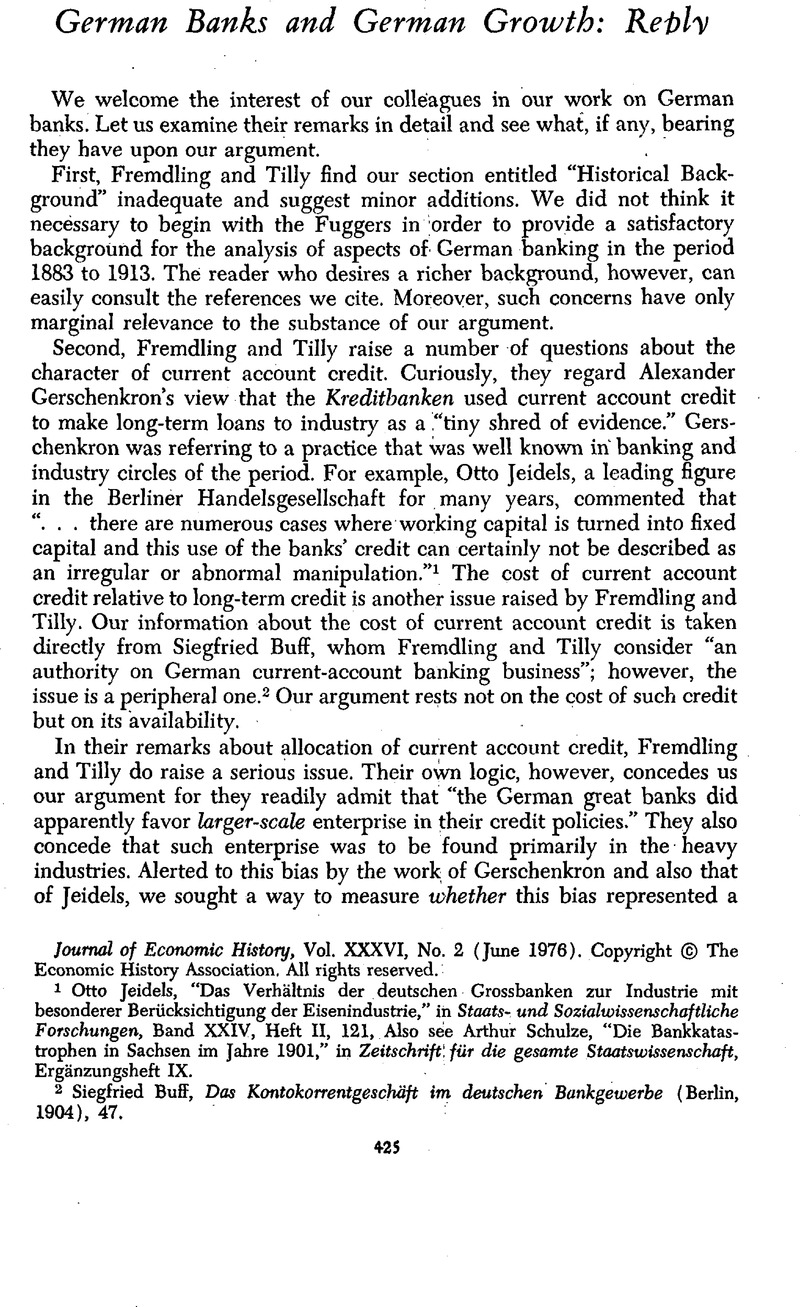Published online by Cambridge University Press: 11 May 2010

1 Otto Jeidels, “Das Verhältnis der deutschen Grossbanken zur Industrie mit besonderer Berücksichtigung der Eisenindustrie,” in Staats- und Sozialwissenschaftliche Forschungen, Band XXIV, Heft II, 121, Also see Arthur Schulze, “Die Bankkatastrophen in Sachsen im Jahre 1901,” in Zeitschrift für die gesamte Staatswissenschaft, Ergänzungsheft IX.
2 Buff, Siegfried, Das Kontokorrentgeschäft im deutschen Bankgewerbe (Berlin, 1904), 47Google Scholar.
3 Neuburger, H. and Stokes, H. H., “German Banking and Japanese Banking: A Comparative Analysis,” Journal of Economic History, 35 (March 1975), 238–252CrossRefGoogle Scholar.
4 In the appendix of our paper we defined “capital in non-agricultural sector = total capital stock derived from Hoffmann (page 26, col. 2) times the percentage of capital that is not agriculture derived from Hoffmann (page 44).” The raw capital stock was derived by successively multiplying the rates of growth. If γi is the rate of growth in period i, the total capital stock in period k, Kk, can be calculated.

if we assume K1 = 1.00.
We have taken our raw capital stock series, calculated using the above formula and used Hoffmann's data on the percentage of capital that is not agricultural to form the non-agricultural capital stock. The resulting series is correlated .999556 with a capital stock series derived (as suggested by Fremdling and Tilly) from Hoffmann page 253 (Col 7 – Col 1 – Col 3) in the period 1886–1913. (For the correlation calculation both series have been rounded to three significant digits.) Thus both techniques for calcalculating the capital stock give similar results.
5 Eistert, Ekkehard, Die Beeinflussung des Wirtschaftswachstums in Deutschland von 1882 bis 1913 dutch das Bankensystem (Berlin, 1970), 97Google Scholar.
6 Footnote 22 of our original article clearly explains that if ρ (a substitution parameter) is not significantly different from zero, then the elasticity of substitution (σ) is equal to one since σ = 1/(1+ρ).
7 Berndt, and Christensen, , “Testing for the Existence of a Consistent Aggregate Index of Labor Inputs,” American Economic Review, 64 (June 1974)Google Scholar have indicated that they concur with the findings of Solow, “Technical Change and the Aggregate Production Function,” The Review of Economics and Statistics, 39 (August 1957) p. 400Google Scholar, who notes that if the “researcher is only interested in explaining a time-series of outputs, he loses little by using aggregate inputs.” Since the problem of the aggregate production function only arises if one attempts to measure trends in factor shares, something that we did not attempt to do, our use of the production function is appropriate.
8 Neuburger and Stokes, “German Banking and Japanese Banking.”